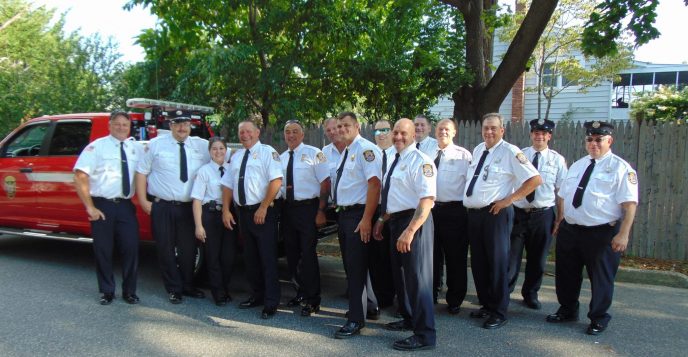Happy Labor Day from TBR News Media
The staff at TBR News Media wishes you a Happy Labor Day! The office will be closed on Monday, September 5 but will reopen on Tuesday, September 6 from 10 a.m. to 4 p.m.
TBR News Media Police Blotter for issue of Sept. 1, 2022
The following incidents have been reported by Suffolk County Police:
Centereach
■ Walmart on Middle Country Road in Centereach reported a shoplifter on Aug. 27. A man walked into the store, picked out a mountain bike valued at $98, and allegedly rode out of the store without paying.
Commack
■ Walmart on Crooked Hill Road in Commack reported a shoplifter on Aug. 25. A man allegedly took a USB drive and an LED work light off the shelf and walked out without paying.
■ Home Depot on Crooked Hill Road in Commack reported that two men allegedly stole electrical wiring valued at approximately $460 on Aug. 25.
■ A catalytic converter was stolen from a 2004 Honda Accord parked in the driveway of a resident on Partridge Drive in Commack on Aug. 23.
■ A woman shopping at Costco on Garet Place in Commack on Aug. 27 reported that an unknown person stole her purse out of her pocketbook.
■ Walmart on Crooked Hill Road in Commack called the police on Aug. 27 reported a petit larceny. Two men stole assorted baby furniture valued at $150.
Dix Hills
■ Cash and credit cards were stolen from a vehicle parked in the driveway of a residence on Redwood Drive on Aug. 26. The vehicle had been left unlocked.
East Northport
■ T-Mobile on Clay Pitts Road in East Northport reported a petit larceny on Aug. 25. Two men entered the store on Aug. 25 and allegedly stole an iPhone 13 Pro valued at $600.
Greenlawn
■ A resident on Robin Drive in Greenlawn called the police on Aug. 26 to report that someone broke the driver’s side window of his vehicle and stole a wallet.
Hauppauge
■ A resident on Cain Drive in Hauppauge reported that unknown suspects removed all four tires and rims, valued at $1100, off of his 2021 Toyota on Aug. 23. Three windows of the car were also broken.
Huntington Station
■ Anthropologie at the Walt Whitman Mall in Huntington Station reported a petit larceny on Aug. 26. A man and a woman allegedly stole approximately $510 worth of women’s clothing.
■ Sephora on Walt Whitman Road in Huntington Station reported that a man and a woman entered the store on Aug. 24 and allegedly stole assorted fragrances valued at $2800.
Lake Grove
■ PacSun at the Smith Haven Mall in Lake Grove reported that three women allegedly stole $585 worth of assorted clothing from the store on Aug. 26.
■ A catalytic converter was stolen from a 2005 Honda Accord parked on Bayard Street in Lake Grove on Aug. 24 and from a Honda Element on Sterling Drive in Lake Grove on Aug. 25.
Melville
■ A man checking out of the Melville Marriott Long Island on Walt Whitman Road in Melville on Aug 26 found his Budget rental car in the parking lot missing all four tires and rims. The parts were valued at $800.
Miller Place
■ A Shimano bicycle valued at $400 was reported stolen from the Friendly’s parking lot on Route 25A in Miller Place on Aug. 25. The bicycle had been chained up to a light post.
Nesconset
■ A woman shopping at Shoprite on Nesconset Highway in Nesconset on Aug. 25 reported that an unknown person stole her wallet containing cash and credit cards from her pocketbook.
■ Catalytic converters were reported stolen from 2007 Honda Accord and a 2004 Honda Accord parked on Roy Drive, a 2004 Honda Accord parked on Yardley Lane, and a 2006 Acura parked on Commander Lane in Nesconset on Aug. 24 and 25. The parts were valued at approximately $500 each.
Rocky Point
■ Catalytic converters were reported stolen from a 2004 Honda Accord on Fern Road, a 2001 Honda Accord and a 2007 Honda Accord on Hickory Road, a 2001 Acura MDX on Rosewood Road, a 2007 Honda Accord on Patchogue Drive, a 2006 Honda Accord on Magnolia Drive and a 2004 Honda Accord on Tulip Road in Rocky Point from Aug. 24 to Aug. 26.
Selden
■ A man shopping at 7-Eleven on Boyle Road in Selden on Aug. 26 returned to his car to find that an unknown person had entered his unlocked vehicle and stole a large amount of cash.
■ Home Depot on Middle Country Road in Selden reported a grand larceny on Aug 26. Three men allegedly stole various power tools and a tool box with a total value of $1860.
■ A resident on Strauss Avenue in Selden reported that an unknown person had stolen his mailbox between the hours of 7 p.m. on Aug. 25 and 5 a.m. on Aug 26. The mailbox was valued at $80.
Sound Beach
A resident on Beacon Drive in Sound Beach called the police on Aug. 25 to report that a catalytic converter was stolen from his 2005 Honda Element.
Suffolk County Crime Stoppers offers a cash reward for information that leads to an arrest. Anyone with information about these incidents can contact Suffolk County Crime Stoppers to submit an anonymous tip by calling 1-800-220-TIPS.
— COMPILED BY HEIDI SUTTON
Editorial: Sustainability starts in our own backyard
Climate change presents numerous challenges that seem to multiply with each passing year.
It is an uncomfortable truth that we must make permanent changes to our own lives or face catastrophic consequences, some of which we are already seeing. Amid a brutally hot and unseasonably dry summer here on Long Island, the human race is simultaneously fighting droughts and flash floods not only in the U.S. but throughout the world.
Though many of the changes needed to counteract climate change will require government intervention, there are a number of ways that citizens can help make a difference, starting with their own backyards.
A typical American lawn consists of freshly cut grass, no weeds in sight, and pesticides covering every square foot. Unfortunately for us, this pretty picture is pretty bad for the health of our local environment. While the manicured lawn makes for the ideal suburban homescape, the environmental harms outweigh the aesthetic charms.
Gas-guzzling mowing equipment has the obvious downside of polluting the air. In addition to killing off weeds and insects, pesticides and insecticides can contaminate water in our aquifers, harm birds and kill off beneficial insects and plants that stabilize the local ecosystem.
Instead, residents should opt for electric-powered mowing equipment, which can deliver the desired outcome without polluting our air. Additionally, one can avoid adding harsh chemicals into the groundwater by introducing pest-controlling insects native to Long Island.
In the TBR News Media coverage area, one Long Island citizen has converted her home into a haven for the endangered monarch butterflies. Theresa Germaine, an 83-year-old Stony Brook resident, used her time during the COVID-19 lockdown to raise monarch butterfly eggs using milkweed, the only host for monarch caterpillars, in her garden. After raising the caterpillars into metamorphosis, she releases the beautiful monarch butterflies into nature.
Germaine teaches us that the contributions of the few can go a long way to improve the greater whole. With each monarch butterfly that leaves her garden, that population is a little more stable and our world a little more colorful. Germaine encourages everyone to join her cause: To plant milkweed so that the monarchs can thrive in the world.
Conservation practices require us to make individual sacrifices, but through these small concessions we contribute to creating a better world. It is imperative that we do not forget our personal responsibility in protecting and helping our environment.
It is important to remember that climate change is a global phenomenon affecting every organism on this planet. The decisions that we make today will impact others tomorrow.
D. None of the Above: SB Basketball Coach Langford reflects on new league, second year
By Daniel Dunaief

Parents, coaches and teachers offer words of wisdom, guidance and advice.
At the same time, however, they also have opportunities to learn, particularly after the end of one year and the start of another.
And so it is for Stony Brook University women’s basketball coach Ashley Langford.
A year after she took her first head coaching job at Stony Brook, Langford took stock of her experience, while contemplating the next steps.
“I’m still high energy and enthusiastic,” Langford said at 3 p.m. .on the first day of school from her car as she headed to a late lunch. “I’m still excited to be head coach.”
A self-described “high achiever” who “wants to be the best,” Langford acknowledges that she may be an over achiever as well.
“Even when I reach my goal, for me, you’re supposed to,” she said. “There were times [last year] when we would win and I wouldn’t be happy. I want us to be our best.”
Langford, however, recognizes that emphasizing ways to improve, even after winning a game, was not ideal for her players.
“They are 18- to 23-year-olds,” she said. “They need to enjoy that win, regardless of how it looked. They need to be praised right in the moment.”
That doesn’t mean teaching and improving ends after a win. The next day, she said she felt more comfortable talking about how to avoid the possibility of letting a game slip away.
In her second year, Langford hopes she, her coaches and the team become more visible to the community, particularly because the team plays a “fun brand of basketball.”
Her debut season involved ongoing restrictions related to the pandemic, preventing her from connecting with the community.
“I need to be more visible,” Langford said. “It’s important that Long Island knows who we are.”
She is eager to go into schools and engage with members of the community.
“Community service is a huge piece of that,” Langford said. “It’s us going to schools and reading” or interacting in other ways with residents.
This summer, the basketball program ran an elite camp for players who were not at a recruitable age. Participants in the camp can come back to games for free, which, Langford hopes, can encourage other spectators to join them.
“Maybe they’ll bring a friend or two,” she said.
The Seawolves coach is excited for the opportunity to compete in the Colonial Athletic Conference. After participating in the America East conference since 2001, the Stony Brook Athletic Department decided to move to the CAA starting this season.
Langford will rely on some of her knowledge of her competition. Prior to arriving at SBU, Langford spent four years at James Madison University, which is a member of the CAA.
“I know the DNA of certain teams,” Langford said. She recognizes, however, that teams change, which means that the Seawolves have to be “ready to pivot.”
As she prepares the team, which includes four transfer students, for the upcoming season, she believes Stony Brook will be competitive in a demanding conference.
“We’re not in a league where you can have an off night and think you’re gong to win,” she said. “We’ve got to be ready to give our best.”
Thoughts from a former player and her father
Former fifth-year player India Pagan, who is preparing to play professional basketball in Germany this winter (see story in Arts and Lifestyles), remains connected to her former team.
“I’m really proud that we made it to another league,” she said. “We have to elevate our level, our intensity. I say, ‘We,’ like I’m still on the team.” Pagan said she still feels committed to a team she helped lead to consecutive conference championships.
Thinking back to the beginning of his daughter’s college basketball experience, India’s father Moises Pagan cited Stony Brook’s eagerness to recruit her.
“The fact that they put this powerpoint together, it blew us away,” Pagan said. “We walked away saying, ‘Stony Brook really wants our daughter.’”
Between You and Me: Solving ‘help wanted’ with immigrants as a first step
By Leah S. Dunaief

Busloads of immigrants are arriving in New York City regularly, sent from the border by the Texas governor. He doesn’t know what to do with so many, but we do. We up here in the northeast can use a lot of help, to judge from the omnipresent “Help Wanted” signs.
Of course, the newcomers cannot fit into communities seamlessly, functioning in any and every job. First, they need food, housing and perhaps medical care. Their children need to be registered for school. The parents have to be interviewed to determine their skills and preferences for work. To us, it would seem there are a number of jobs that they might fill fairly quickly even if they come with no special training, and especially if they have the benefit of a translator on the work premises or on the phone.
Restaurants in particular seem to be in need of additional help. Some positions there need energy and elbow grease, like busing tables, washing dishes and keeping the rooms clean. The same might be said for other parts of the hospitality and entertainment industries, like hotels and theaters. Hospitals need additional hands for cleaning and helping patients. Businesses and offices must be kept clean and neat. The same for private homes.
Of great need is childcare, which in effect is a universal job but one for which applicants would have to be carefully screened. There is $7 billion of public funding available for childcare from New York State, but only some 12% of those who might qualify are aware of the program. An intense information campaign has been proposed to get the word out, and once there is a greater response, more caretakers will need to be retained and trained. The money is there to pay them.
New York City has long been the gateway to America for immigrants. And America has long been the promised land for those fleeing persecution, political chaos or even war at home, or those hoping to better themselves and especially their children in a country that offers opportunity.
We are a nation peopled by immigrants. While some families can brag about their long lineage here in America, the point is that at some time, ancestors came here from somewhere else, unless they are Native Americans. And the striving of immigrants to succeed and fit in has helped our country to succeed. Imagine what it must take to pull up roots, leave behind everything you know and those you love, and travel, in some instances great distances along perhaps dangerous routes, to come to America. Many don’t speak English. Others never make it here.
To do so must take great courage, determination and ambition. These are skills we need. And we need people. In addition to the evidence of Help Wanted signs, we know that our birth rate is dropping. More and more couples are opting not to have children, whether because of the expense, (some $300,000 per child today), the challenge of climate change or any other reasons.
We have a checkered history at best when it comes to welcoming immigrants. When I was growing up in New York City, for example, Puerto Ricans were arriving in substantial numbers. They were generally disparaged, accused of taking “American” jobs and causing crime. Leonard Bernstein’s “West Side Story” is a fairly accurate depiction set to music. Newcomers have had to elbow their way into the country, largely because they start out being culturally different, and differences are often feared.
My neighborhood as I was growing up, Yorkville, was largely populated by Germans. Restaurants advertised various krauts and wiener schnitzel. Beer halls lined East 86th Street, with polka music spilling onto the sidewalk, luring in passersby. Some residents, who had arrived generations earlier, made fun of them and their accents. Then in my teen years, the Germans moved up and out to the suburbs and elsewhere and were replaced by Hungarians, and the restaurant “specials” signs now offered “veal paprikash.” Again the same cycle.
New York City renews itself with its immigrants. So does America. We need them to remain us.
Environmentalists, residents rally in Head of the Harbor to block private docks
A rally held at Head of the Harbor’s Cordwood Park Aug. 27 combined a bit of history, nature’s beauty and activism in one short hour.

The Rally to Block the Docks, organized by Head of the Harbor resident Lisa Davidson, attracted dozens of local residents, environmentalists and Stony Brook University students. Village residents have voiced concerns over the possible construction of a 186-foot dock on private property next to Cordwood Park and the potential of another 200-foot dock a few houses away. The footage includes a combination of permanent and floating docks. A Sept. 6 Village of Nissequogue Planning Board meeting currently has a vote scheduled regarding the 186-foot dock.
Protesters cited among their concerns the 186-foot spoiling the view of Stony Brook Harbor and restricting access to those walking along the beach or using their canoes and kayaks in the water. Many also feel it may encourage other homeowners to build similar private docks, leading to harbor pollution due to more or large boats.
“One property owner should not be allowed to ruin what is cherished and loved by an entire community,” Davidson said.
Among the speakers at the event were state Assemblyman Steve Englebright (D-Setauket); Kevin McAllister, founder and president of Defend H2O; John Turner, conservation chair of Four Harbors Audubon Society; and Head of the Harbor/Nissequogue historian Leighton Coleman.
Davidson is a member of the Joint Village Coastal Management Commission, a waterfront board of the villages of Head of the Harbor and Nissequogue. She said she recused herself from the commission on the matter of private docks.
“Because after seeing the numerous petitions we get for private docks, I realized that this beautiful bay is in grave danger if we as a community do not come together and take action now before it is too late,” she said.
She encouraged residents to reach out to the Town of Smithtown and New York State Department of Conservation, both of which approve first-phase private dock permits, to prevent future approvals. Davidson said homeowners might argue that they have riparian rights. She said those rights are satisfied when walking in the water or taking a kayak or canoe out on it, and do not include building docks.
Because the harbor is shallow, the dock must be meet DEC requirements that it stands in 3 1/2 feet of water even at low tide, hence the lengths of the proposed docks.
McAllister said, based on his experience, when one dock is built, there tends to be a push for more docks and bigger boats in the body of water, which he said leads to issues in the water such as prop dredging and salinity problems where the water is always cloudy.
Coleman said commerce once took place at the park, which had a negative impact on the harbor.

“We are now standing at the site of what was once an active boatbuilding yard and shipping port, where New York City’s manure was traded for cordwood to fuel the city’s numerous town houses,” the historian said.
He added, eventually, a boatyard’s use of arsenic to cure wood along with human and livestock waste runoff affected the harbor’s health. It was in the 1870s that Smith siblings, descendants of Smithtown’s founder, bought up large parcels of land. The harbor was then used for more leisurely activities, he said, until the 1920s brought to the area “commercial dredging for mining of sand and gravel, and the subdivision of the large estates into developments,” which threatened the waterway’s health once again. This led to the formation of incorporated villages, which in turn created zoning laws to protect the harbor and, in the 1940s, the Stony Brook Harbor Association was created.
“Sadly, the old guard has passed on, and we were left, apparently, with a false sense of security that our harbor’s healthy future was in safe hands, but thankfully as of today I see that we have a new generation of stewards stepping forth,” he said.
In the 1920s and ’30s, when there was dredging of the harbor as well as others on the North Shore, Englebright said, it was important that villages were formed to protect them. He called those who wanted to dredge the waters “essentially gangsters” who were “buying influence” with the towns, and “the towns were selling out the harbors.”
“That is the legacy of this village,” Englebright said. “That’s your birthright. That’s how you came into existence as a municipal jurisdiction in state law. There was no other way at the time to prevent the disposition of the permits by the towns.”
He added, “The Town of Smithtown has sold out the harbor bottom with approving the initial permit for a dock.”
Englebright said the body of water’s bottom is public property and “to give away public property is illegal.”
“It’s an echo of the outrage that led to the creation of these villages,” he said.
While waiting for the rally to begin, Turner said he saw a bald eagle, osprey, snowy egrets and more.
“Any time hiking the harbor, you know that the harbor, from an ecological and biological perspective, it’s just a really vibrant ecosystem,” he said.
Turner added there are several diamondback terrapins in the harbor, too. The DEC has listed the decrease in the animals a concern. They come ashore in June to lay their eggs, Turner said, and a dock could increase human traffic which in turn could have an adverse impact on the terrapins.
“We hope that the villages and the Town of Smithtown will not grant private access to a public trust resource that could ultimately have a really adverse impact upon the harbor,” he said.
Turner added he looked at the Suffolk County GIS viewer and counted approximately 54 properties around the harbor.
“If these are approved, what prevents those other 52 or 50 owners down the road from requesting permits to build docks — docks that are on the same scale as what these are,” he said.
To pay homage to the history of the location, rally organizers served ginger ale and root beer, and the Once Upon a Tyme Barbershop Quartet performed for the attendees at the beginning and end of the rally.
Davidson said she and others have been working on circulating a petition which they will present to the Nissequogue Planning Board on Sept. 6.
St. James firefighters celebrate 100 years of service
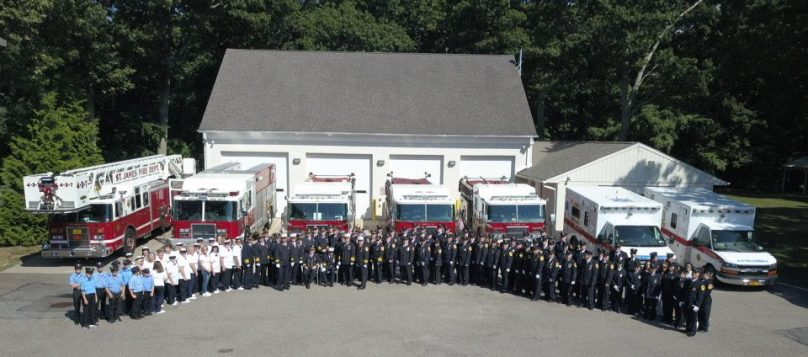




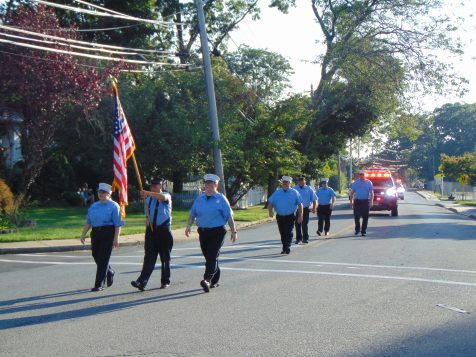




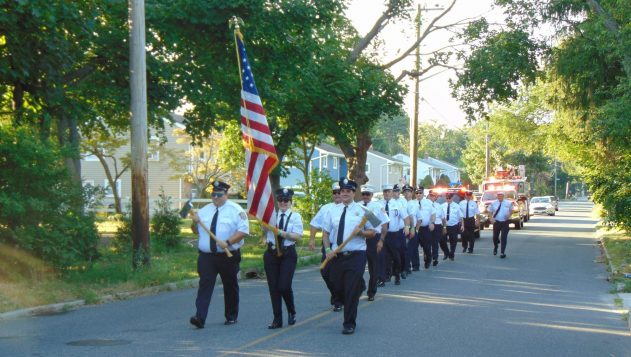














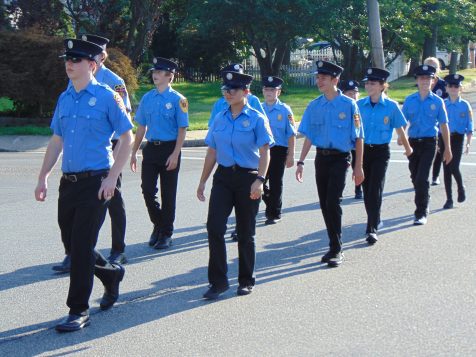




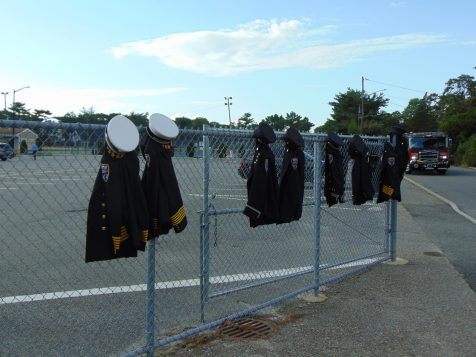









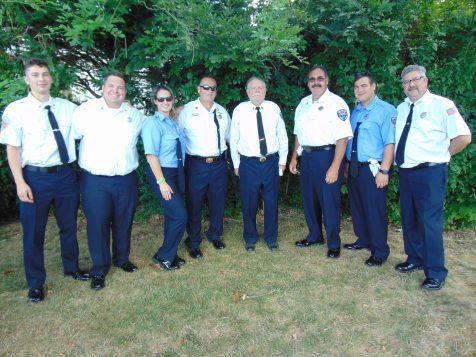

The streets of St. James were filled with volunteer firefighters from across Suffolk and Nassau counties as they turned out to honor the St. James Fire Department’s 100th anniversary on Aug. 27.
Mid-afternoon, first responders from more than 20 departments and their emergency vehicles began lining up at Smithtown High School East and down streets along Woodlawn Avenue for the St. James FD’s 100th anniversary parade. The parade kicked off after 5 p.m., and spectators lined Woodlawn and Lake avenues to cheer the firefighters on.
At the end of the parade, participants and residents gathered at St. James Elementary School for a party that featured a battle of the bands, refreshments, activities and music. The night was capped off with Fireworks by Grucci.
Chief of Department Frank Sapienza said the committee had been working on the event for 10 years. Sapienza, who has been with SJFD for more than 20 years, added, “It was one of the best times I’ve had with the department.”
According to the St. James Fire District’s website, while a department was organized in the hamlet in 1909 as the Eagle Hook & Ladder Co. by T. Edward Ellis, interest in the company declined by the early 1920s.
After a Christmas holiday fire in 1921, residents formed a committee and initiated a drive to raise money for a new firehouse and equipment. The new department was formed on March 8, 1922. The first piece of equipment the committee purchased was a Model T combination pump and ladder. The cost was $1,500, and it was stored in a metal garage at the intersection of North Country Road and Lake Avenue where the firehouse sits today. The property belonged to Lawrence Butler, who donated an engine floor, when the firehouse was built in 1923. Volunteers built the second floor, and an additional wing was added to the building later.
According to the district’s website, in the department’s early days, volunteers would raise money by organizing annual carnivals that would kick off with a parade. The week-long events featured circus and vaudeville acts nightly until 1935 when the fire district was formed and volunteers were no longer responsible for raising money for new equipment.
Lidl to open new store in Commack Aug. 31
Lidl has announced that it will open its 23rd store on Long Island on Wednesday, Aug. 31. Located in the Mayfair Shopping Center at 210 E. Jericho Turnpike in Commack, the grocery store will celebrate its grand opening with a ribbon cutting at 7:40 a.m. The first 100 customers in line before the ribbon cutting will receive gift cards ranging from $5 to $100 each. Shoppers can also enter to win a $500 Lidl gift card, sample Lidl’s award-winning assortment and take advantage of special giveaways throughout the day, according to the franchise. The 30,000-square-foot store will employ more than 50 people and will be open daily from 8 a.m. to 10 p.m.
Reminded how crucial learning self-defense is in today’s world

When my husband told me about a women’s self-defense class on Aug. 22 at the jiu jitsu center where he and his daughter train, I jumped at the opportunity to attend. The fact that it was free to those who signed up before Aug. 22 was an added bonus.
It’s been a long time since I had to avoid unwelcome gestures at bars or being picked up — including physically — by men. Still, with current headlines citing increased crime, including in nearby New York City, it was time to brush up on some skills.
It had been more than 20 years since I was in a similar class. Before I stepped into the dojo at American Jiu Jitsu Centers on Lake Avenue in St. James Monday night, I only remembered one or two techniques. One is to hold my keys a certain way if it’s dark or I feel I am in danger, and go for a person’s crevice in their neck if they threaten me.
After Monday night’s class, I have a few more techniques in my arsenal.
Led by the school’s Shihan Francine and Sensei Charlie, other black belts and lower rank students were on hand to help with approximately two dozen women in attendance.
The importance of learning how to protect oneself was stressed in the hour-long class. The two head instructors were the perfect match to lead the class. Sensei Charlie is tall and muscular, while Shihan Francine is petite, standing 5 feet 3 inches. Charlie joked during one demonstration that he could bench press three times her weight, but that didn’t stop Francine from being able to push him to the ground while showing the women a defense move.
During the class, Sensei Charlie shared some statistics from Bethpage-based The Safe Center with the students. Among the stats, as far as experiences with attempted or complete rape, 1 in 5 women and 1 in 33 men have reported such cases. The center’s Human Trafficking Department in 2019 responded to 500 human trafficking victims, both adults and youth. Violence also happens in private homes with the center reporting 1 in 3 women and 1 in 4 men being victims of domestic violence in their lifetimes.
To me, it’s always shocking that while men can also be attacked, more women still find themselves as victims. Living in suburbia for decades, sometimes I forget the importance of being aware of my surroundings and knowing what to do if danger presents itself. Something I was more conscious of when I was a child in Queens or frequently traveling to Manhattan in my younger years.
One of the most important things I learned from the class is the first thing to do, when a person approaches you, is back away. Then maintain a nonconfrontational stance, and say, “Hey, I don’t want any trouble.” At the same time, it’s crucial to bring your arms up, hands in front of your face, to let the person know that you can defend yourself if needed.
Shihan Francine and Sensei Charlie shared several techniques with the women, such as heel-palm, knee and eye strikes. A main technique includes a combination of a kick, followed by a heel-palm strike, knee to the groin followed by a blow with an elbow. One of the most important things stressed was to shout “No!” with each move and to do so loudly.
The sequence and others were repeated several times, and students were able to practice with each other and the black belts.
I enjoyed that combining techniques was just like learning dance choreography, and I found the repetition helpful.
The importance of repetition was stressed so that the techniques come naturally. Shihan Francine said the sequence of moves wasn’t as important as remembering each of them. One student she knew years ago was attacked on the subway. Even though he only remembered to kick, she said the main thing is that he did something.
The black belts on hand shared advice to remember every day such as walking with confidence, looking people in the eyes when passing them, being aware of your surroundings and not putting earpods in both ears. Facing one’s back to a door or wall when stopping to make a phone call or to text is also important.
Sensei Charlie and his daughter as well as my husband, Joe, and my stepdaughter Summer gave demonstrations. Seeing young teenage girls being able to take down grown men sent the message home that women don’t need to be damsels in distress anymore with proper awareness and a bit of training.
After the class, I reached out to Shihan Francine and she said that American Jiu Jitsu Centers, which was founded by head instructor O’Sensei Joe Puleio, “is always delighted to host free martial arts seminars for women and welcomes the chance to give back to the communities of St. James and surrounding areas.”
Shihan Francine has taught several of the women’s self-defense classes at the school and has seen this empowerment on a regular basis.
“It is great to see new people learn practical defense techniques in under an hour,” she said. “It is even more exciting for me, though, when some of the participants are empowered enough to continue their training and join us on the mat every week.”
She added that there are many women who train at the St. James location: “These ladies continue to practice their skills several times a week and have the strength and confidence to defend themselves against an attacker.”
For more information and the opportunity to take a free trial class at AJJC, visit ajjctraining.com.
Rita J. Egan is the editor of The Village Times Herald, The Times of Smithtown and The Times of Huntington & Northport.




















